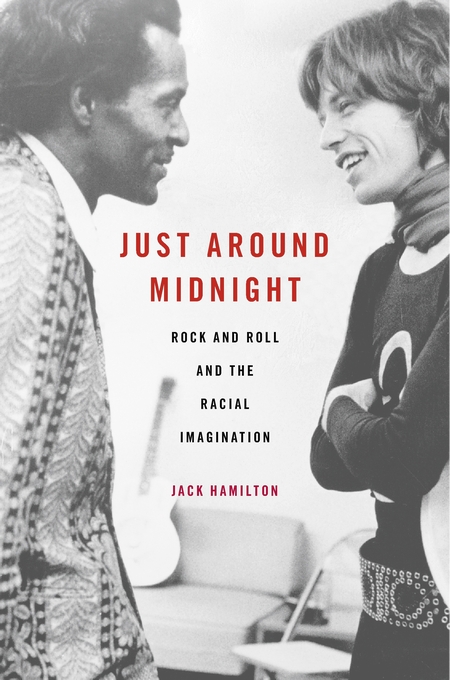When Chuck Berry, an African-American, released “Johnny B. Goode” in 1958, it became a megahit with both black and white audiences at the dawn of the rock ’n’ roll era.
When Jimi Hendrix died just 12 years later, obituaries wrote about him as an anomaly, the unusual case of a black man finding success in what was perceived as the white man’s genre of rock ’n’ roll.
The University of Virginia’s resident rock historian, Jack Hamilton, has been researching what caused this dramatic shift in the racial perception of popular music. In his new book, “Just Around Midnight: Rock and Roll and the Racial Imagination,” the assistant professor of media studies and American studies tracks the evolution of the genre through its golden age in the 1960s.
“Although no one can say for sure who invented rock ’n’ roll, I think Chuck Berry’s got as good a case as anyone,” Hamilton said. “But the music that he made in the late ’50s and early ’60s isn’t played on classic rock stations. You’ll hear the Rolling Stones and U2 – a band that started 15 years after the Stones – on those stations. That’s odd when you know that Berry was one of the Rolling Stones’ biggest influences and that they were releasing hits during the same time period.”
Hamilton believes that attitudes within the record industry and among music critics led to this shift in classifying rock in the 1960s. In the mid to late ’60s, there was a growing tendency to view music by black artists as older, unpolished source material for white rockers even though they were often producing hits contemporaneously.
“This isn’t an entirely new phenomenon. Going back to the 19th century at least – it’s heavily documented then, but it certainly precedes that – is this tendency to think about black music as primordial, primitive and pure, rather than as popular or even edgy and experimental,” Hamilton said.
He sites the example of Paul Whiteman, a famous white bandleader in the 1920s who reportedly said he wanted “to make a lady out of jazz.”
“Again that’s an example of a white musician taking a form invented by black Americans and saying, ‘Oh we’re going to take this and make it more ‘sophisticated’ and palatable and hone down its rough edges,’” he said.

This process didn’t start with rock ’n’ roll until later in the ’60s. The early 1960s saw a high level of musical conversation between black and white musicians, and successful pioneers like Motown founder Berry Gordy opened up the airwaves for more black artists by proving there was a demand for their music among white audiences.
Tracing the Rolling Stones’ rise to stardom provides one of the clearest examples of the shift in views of rock ’n’ roll from this early collaborative period to the transformation into a white man’s genre in the late ’60s. That’s why Hamilton’s book takes its title from the lyrics of what is likely the band’s most controversial song of all time, “Brown Sugar.”
“In a lot of ways, the Rolling Stones are sort of the quintessential band for what the book is about, and ‘Brown Sugar’ is one of the most disturbing and racially troublesome songs in history,” Hamilton said. “I really believe that to truly and honestly grapple with the history of rock music you have to grapple with that band, and that song in particular, so it felt appropriate for the title.”
It’s well known that the Rolling Stones were heavily influenced by blues icon Muddy Waters and that they have toured and collaborated with African-American musicians throughout their careers. However, Hamilton points to a shift in the way they’re viewed by critics and fans in the late 1960s. A school of criticism known as “rockism” emerges in the 1960s that holds up rock ’n’ roll as the purest most artistic form of music, and scorns other forms of popular music. Rockism demands a level of authenticity among rockers that is really only accessible for white male musicians.
“These critics argue that the fact that music by African-American artists is selling to white audiences means that it’s not ‘authentically black,’ and in their minds if it’s inauthentic and not true to one’s perceived creative self, then it can’t be real rock,” Hamilton said. “It’s largely white critics who are making these claims.”
Whether or not bands like the Rolling Stones were complicit in the spread of this viewpoint – there is an argument to be made that they weren’t, given their well-documented support of black musicians – the success of “Brown Sugar” seems like a metaphor for the shift in racial perception of rock ’n’ roll.
Written in 1969, the lyrics to “Brown Sugar” play directly with images of slavery and racial subjugation. It was an instant hit when it was released in 1971, a year after Hendrix’s death and at a point when critical review saw rock as the work of white musicians.
Hamilton argues that it’s only within the last 20 years that people have started to recognize and push back against the rockism school of thought. As that happens, he hopes to see the classification of modern and classic rock change, and maybe even hear his favorite song on classic rock radio.
“My favorite rock ’n’ roll song is one that some people wouldn’t call rock ’n’ roll at all, but I absolutely would. It’s ‘I Want You Back’ by the Jackson 5,” said Hamilton. “I think it’s the greatest pop song ever written, and I’m using pop as an all-encompassing designation that includes rock ’n’ roll and all forms of popular music.”
Readers can find out more about Hamilton’s analysis of popular music and racial perceptions of rock in “Just Around Midnight,” which is on sale now.
Media Contact
Article Information
September 14, 2016
/content/school-rock-professor-probes-rock-n-rolls-complex-racial-history

